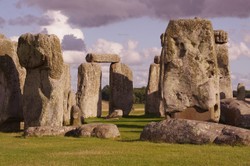British law states that prior to building work commencing major construction projects perform an archaeological survey to prevent valuable heritage being lost. Most digs produce routine finds of no great significance, but occasionally you get a big find. The small village of Harpole, set in rural Northamptonshire, a green and pleasant part of rural England, was recently the scene of such a find. The excavation of the site of a new housing estate turned up a grave, and this was the resting place of a woman of high status, judging from the grave goods interred with her.
The archaeologists have had to infer that the buried person was female. You can normally tell the sex of a skeleton by studying the pelvis, which differs in males and females, but in this case the acidic soils of the east midlands have all but destroyed organic remains, be they flesh, wood or wool, leaving solid grave goods made of metal, along with finger and toe nails, which decay slower than bone, and some bits of wood. Significantly it was a bed burial. The residents of the area were Angles, a tribe who settled in much of England. Their noblemen or kings had a tradition of ship burials, as at Sutton Hoo, and over the ship was heaped a tumulus of Earth, but women had bed burials, in which a bed was laid in the grave and the body deposited on it. Though the wood of the bed had rotted, the imprint of the bed had been left in the soil. Women were also buried without weapons, unlike men who took weapons into the grave with them. There were no weapons in this grave. This was not a person who saw weapons as integral to her identity.
The spectacular find was a necklace. It was composed of golden Roman coins and garnets. Though the date of the burial was probably late 600s, Roman coins were still in circulation in Britain, and the Anglo-Saxons valued them. Those who think of them as crude barbarians may be surprised to know that these Germanic settlers valued Roman things and saw themselves as heirs of Rome. However, there were some pieces of the necklace which were incised with the marks of the cross. Furthermore, a cross was placed under the body. This woman was a Christian buried by people who either shared or respected her Christianity. Such a rich burial shouts princess.
The presence of grave goods generally marks a pagan burial, but the rules for Christians had not been fully finalized then, and even if the church forbade grave goods, as it later did, wealthy and powerful pagan relatives of the deceased could make their will felt.
But who was she?







 TheThousand Year Garden29 days ago
TheThousand Year Garden29 days ago
 Women of the Gospelson 10/11/2025
Women of the Gospelson 10/11/2025
 Religious Gardenson 08/25/2025
Religious Gardenson 08/25/2025
 Doctor of the Church: John Henry Newmanon 08/03/2025
Doctor of the Church: John Henry Newmanon 08/03/2025




Comments
The site is not easy to excavate, so there could be other burials. Some women went into contents and became nuns on their husband's deaths. Most did not. Abbesses sometimes wore jewellery.
The Harpole burial is an interesting find, no doubt and the archaeological remains give adequate proof of the origins. Forensic anthropology is quite advanced these days. Combined with archaeological science, it can establish the chronology and the culture at that period.
Were there more burials and bodies found at the site? If this was just one, it will be difficult to analyze though. If she was princess or queen of Mercia, probably more of jewelry would be recovered. If she was an abbess, the necklace might have belonged to her when she was a princess or queen. Was it a practice in those ages to renounce the world when the women lost their husbands? An exciting and interesting topic for archaeologists to dig into the enclosure and investigate further.
Yes, that is the right translation. Why it was called dirt pool no one knows. It might have been very muddy.
Online sources identify the etymology of Harpole as Old English horu and pol, for "dirt pool."
Would those be credible word origins?
If so, why would a place have and keep a name vaunting ;-{ -- or warning ;-D about -- unclean waters?
At the Norman conquest Saxon saints were downplayed and they were not politically in favour with the new ruling class. Some, like Wulstan of Worcester, were so saintly that even the Normans respected them, but there was no urgency in England to canonise Saxons.
The dates of the three daughters' deaths precedes current canonization rules, and in this period just about anyone could proclaim a saint. Once canonization rules were set those proclaimed a saint earlier had to be vetted using a rigorous standard. Have the three daughters withstood the canonization process, or are they called saints in old texts? I believe canonization came about in the 1000s.
The Wizzley page of new contributions gives a bigger, clearer image of what you selected leftward of your title.
Over the last two days, I kept moving from latest comments to the Harpole wizzley by clicking on your name just above the comment boxes. If I had stopped on the contributions page, I would have seen that it's Jesus Christ stumbling with his Cross.
A burial party. I was limited in my choice of image because there are no commercially available images that I could use.
The image leftward of your title makes me think of Brueghel in its townspeople activities.
But, as I've mentioned previously, the computer treats smaller images less clearly than larger.
What would the image be?
I am not sure of its size, sorry.